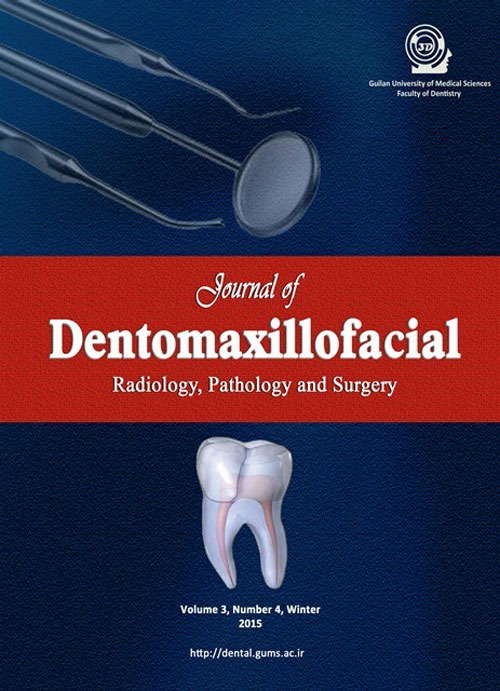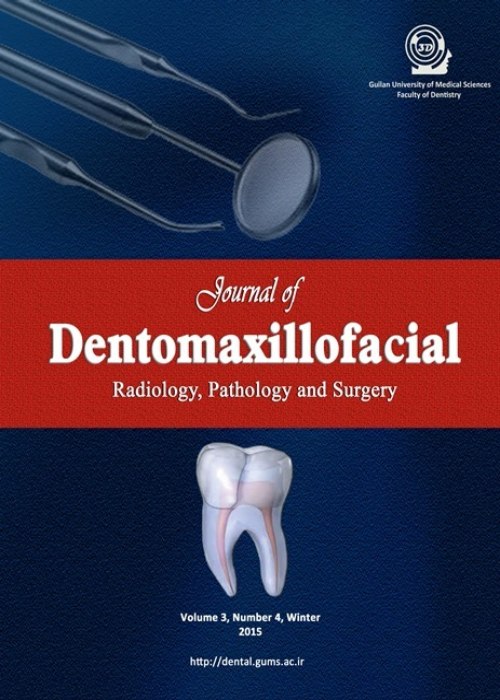فهرست مطالب

Journal of Dentomaxillofacil Radiology, Pathology and Surgery
Volume:5 Issue: 1, Spring 2016
- تاریخ انتشار: 1395/04/06
- تعداد عناوین: 6
-
-
Page 6Introdouction: According to the importance of enamel discoloration and controversy regarding the effect of different orthodontic bonding materials on tooth discoloration, the aim of this study was to determine enamel discoloration following orthodontic brackets using different bonding materials.Materials And MethodsThis in-vitro study, 30 recently extracted human premolars with intact enamel were selected and randomly divided into three groups after primary color measurement (T0). In group A, the specimens were bonded using light-cured adhesive (Transbond XT); in group B, Transbond plus self-etch primer was used; and in group C, unite bond (no-mix) was used on the buccal surface of the specimens. Lingual surfaces, however, did not receive any treatment and were considered as the control group. The samples were immerged in a solution of tea and coffee. After 1 week, the second color measurement was performed (T1) and color changes ΔE between pretreatment and post immergence state was evaluated. The third color measurement (T2) was completed after polishing the surfaces with 24-fluted tungsten carbide polishing burs and rubber cups, and color alterations were evaluated between the base and final state.ResultsStatistical analysis revealed that in all groups, the enamel color on buccal surfaces had statistically significant color changes in comparison with palatal surfaces between the three stages of treatment (P 3.3), and the specimens in group C had the highest amount of changes in all stages of the treatment.ConclusionBracket bonding on enamel surfaces with a number of bonding materials in this study led to detectable enamel discoloration, which was the highest when using no-mix bonding material.Keywords: Adhesives, Tooth Discoloration, Dental Enamel, Orthodontics, Orthodontic Brackets
-
Page 11Introdouction: The aim of the present study was to investigate image magnification in digital panoramic radiography and assess the effect of anatomical sites on the magnification in both males and females.Materials And MethodsIn this retrospective study, digital panoramic radiographs of 48 patients with 202 implants were investigated. Implant diameter and length were measured on panoramic radiographs and the horizontal and vertical magnification rates of each placed area were calculated based on the length and width of the placed implant. A twoway ANOVA test was used to evaluate the magnification rate in regard to implant location and gender.ResultsThe range of the magnification factor of the width was 111.09126.02, which was lowest in the maxillary molar region and greatest in the mandibular anterior region. While the lowest magnification value of the length (111.58) was observed in the mandibular molar region, the highest value (116.09) appeared in the maxillary premolar area. Hence, there were no significant differences in image magnification with regard to anatomical site and gender.ConclusionDigital panoramic radiography can be reliably used for pre-implant evaluation in various anatomical sites of the jaws in both genders.Keywords: Radiography, Panoramic, Radiographic Magnification, Dental Implants
-
Page 18Introdouction: Overhang refers to the extension of restoration material from the cavity. It has an important role in decay, plaque accumulation and periodontal disease, so the aim of this study is determining the frequency of restoration overhang in patients in Anzali, Guilan.Materials And MethodsThis descriptive cross-sectional study was completed using 293 patients who visited for routine check-ups. The overhangs were examined on the basis of the cavity type, restoration type, tooth location, and age by direct observation using an explorer, dental floss. After the initial diagnosis of the overhang, the radiographic reports were examined for final confirmation.Results41.2%, 0%, 18.2%, and 38.1% were observed in cavity classes II, III, IV, and V, respectively. 35.8%, 38.2%, 28.1%, and 25% were observed in mesial, distal, buccal, and lingual regions, respectively. The highest rate of overhang frequency in the first molar teeth was 50% and the lowest overhang amount occurred in the lateral and canine teeth at 25% and 27.3%, respectively. Most amalgam restorations had overhang (37.7%) and the highest amount of overhang was in the upper jaw (42.5%). The highest amount of overhang frequency was observed on the left (41.6%). There was no significant difference in overhang frequency between men and women. The lowest and highest amounts of overhang were observed in the age groups ofConclusionThe overall frequency of restoration overhang was 36.6%, most of which was in class II amalgam restoration in the left first molar teeth in 3039 year-olds.Keywords: Dental Restoration Failure, Dental Calculus, Prevalence
-
Page 24IntroductionThe purpose of this study was to compare the heat generated from different depths of an implant drilling site with and without a sleeve.Materials And MethodsIn this study, 60 cortical bone samples were used and a load of 2.0 kg was applied. rilling for implant surgery, we used a diameter of 4.3 mm and a normal sleeve. Heat was measured from 3 different depths(3,6, and 9 mms). Data was analyzed with a three-way analysis of variance by NewmanKeulsmultiple comparison procedure. The significance level was set to a p-value of 0.05.ResultsThe mean maximum temperature with a sleeve was 35.4°C and without a sleeve was 34.5°C. Thermal rise was lowest in the sleeve group and highest in the sleeveless group. There was a significant difference between the sleeve and nonsleeve group (P= 0.002). There was also no significant differences between the different depths of the three measurements (P= 0.068).ConclusionWithin the scope of this invitro study, thermal rise during implant site preparation was lower in conventional drilling compared to the use of a sleeve. Hence, the difference was statistically significant.Keywords: Dental Implants, Dental Implantation, Temperature
-
Page 30Introdouction: Recent studies have reported the connection between increased risk of cardiovascular diseases and diabetes with the presence of chronic periodontitis. The aim of this study was to determine the relationship between chronic periodontitis and triglyceride, high- and low-density lipoprotein (HDL and LDL), and glucose levels.Materials And MethodsA total of 102 individuals participated in this comparative case-control study and were divided into a test group (51 people with chronic periodontitis with at least two periodontal pockets of >5 mm depth) and a control group (individuals with healthy periodontium or gingivitis). Plasma lipid levels and blood glucose were measured, and the data were statistically analyzed using chi-square and t-tests at pResultsA significant increase in serum triglyceride, cholesterol, and glucose (pConclusionThis study suggested a connection between hyperglycemia and hyperlipidemia with chronic periodontitis, however, the etiology could not be precisely determined.Keywords: Cardiovascular Diseases, Hyperlipidemias, Periodontal Diseases, Risk Factors
-
Page 37Parotid Stafne bone defect is a very rare and infrequent variant, which is located on the buccal or lingual surface of the mandibular ascending ramus. In this paper, a case of parotid Stafne defect, which was incidentally discovered during dental radiographic examination, is reported. This bone defect was observed as a lucent oval-shaped defect on the lingual aspect of the right mandibular ramus. Parotid Stafne bone defect is a rare entity that should not be misinterpreted by radiologists.Keywords: Cone, Beam Computed Tomography, Parotid Gland, Mandible


